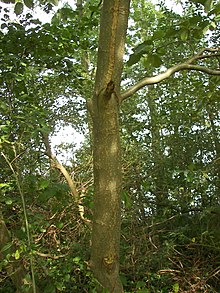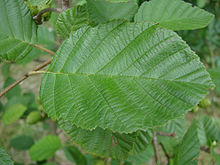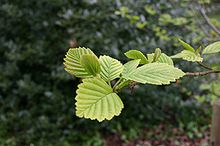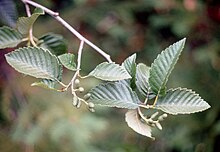Gray alder
| Gray alder | ||||||||||||
|---|---|---|---|---|---|---|---|---|---|---|---|---|
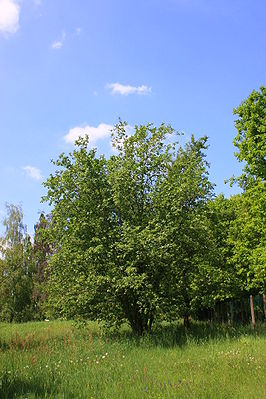
Gray alder ( Alnus incana ) |
||||||||||||
| Systematics | ||||||||||||
|
||||||||||||
| Scientific name | ||||||||||||
| Alnus incana | ||||||||||||
| ( L. ) Moench |
The gray alder or white alder ( Alnus incana ) is a deciduous tree from the alder genus and thus belongs to the birch family . Its distribution area extends from northern, central and eastern Europe to the Caucasus, but is absent in western Europe. In the German-speaking area, it occurs primarily in Austria and southern Germany. Subspecies of the gray alder are found in North America and Asia. The wood of the gray alder is rarely used, as it usually forms crooked trunks with a small diameter. However, it is often used to reforest spoil heaps and to stabilize slopes and embankments. Due to its symbiosis with the Frankia alni bacterium , it can bind the nitrogen in the air and, by enriching it with nitrogen compounds, helps improve the soil.
The widespread distribution of alders and the often minor differences have led to disagreement in the classification of the species. Often representatives of the alder in North America and Eastern Asia are assigned to the gray alder as a subspecies, so the European species is only the nominate form . Most of the article describes the nominate form Alnus incana subsp. Which occurs in Europe and West Asia . incana . The other subspecies are dealt with in separate sections in the system.
description
Manifestation
The gray alder is a summer green tree and reaches a height of 10 to 15, a maximum of 25 meters, and a trunk diameter of up to 40 centimeters. It is single or multi-stemmed, richly branched with a dense crown, but can also grow shrub-like. In poorer locations, the trunks stay short, become crooked or twisted and sticky branches often form . Young twigs are gray-green to reddish brown, clearly hairy at the tips and covered with small, red-brown cork pores .
Bark and wood
In the gray alder, the periderm is retained as a finishing fabric on trunks and branches. No bark is formed ( periderm tree ). The bark is light gray, smooth and hardly cracks even with age. It is loosely covered with cork pores .
Alders belong to the sapwood trees, so core and sapwood are of the same color. The wood is reddish white, reddish yellow to light reddish brown in color. Freshly felled wood appears noticeably orange-red due to oxidation; the color disappears again as the wood dries out. There are numerous fine vessels in the wood, which are arranged in scattered pores. Wood rays are not very pronounced and are only noticeable as inconspicuous mirrors on the radial surfaces. Often, however, the wood rays are bundled into pseudo-wood rays that are more clearly visible. The annual ring boundaries are not very pronounced, but the annual rings are clearly recognizable by the less pore-free and denser latewood. The wood of the gray alder is generally very similar to that of the black alder , is somewhat lighter, less coarse-grained and more shiny.
root
The gray alder forms a heart-root system with strong horizontal roots. It extends horizontally 2 to 3 meters and reaches a depth of 90 centimeters on deep soils. In heavily flooded locations, it forms adventitious roots that can develop into stilt roots . The stilt roots show numerous cork pores.
Buds and leaves
The gray alder forms obovate, non-sticky winter buds with red-violet, initially densely hairy bud scales and up to 5 millimeters long stems. Terminal buds and side buds are about 8 millimeters long.
The leaves are arranged alternately and have petioles 2 to 3 centimeters long. The leaf blade is ovate to elliptical with a double serrated edge and has 8 to 12 pairs of nerves. The upper side of the leaf is dark green, the underside gray-green and hairy gray-tomentose on young leaves. The leaf base is rounded or somewhat heart-shaped, the apex is pointed. The leaf blade becomes 4 to 10 centimeters, rarely up to 12 centimeters long and 3 to 7 centimeters, rarely up to 9 centimeters wide. However, the size and shape of the leaves vary widely. The leaves are shed green in autumn. Two hairy stipules are formed, which are shed early.
Flowers and fruits
Like all alders, the gray alder is wind-flowered and monoecious . The flowers are unisexual and grouped in kitten-shaped inflorescences . Inflorescences with male and female flowers or hermaphrodite flowers are rare. The gray alder blooms from February to March about three weeks before the black alder, which makes it difficult for natural hybrids to develop. The seeds are formed about two months after pollination . The inflorescences are planted in autumn, they overwinter without forming bud scales and begin to bloom before the leaves have sprouted.
The male kittens hang in groups of three to five with soft hairy stalks on branch tips. They are brownish at first, 7 to 9 inches long and have dark brown bracts , which are often provided with a dark spot in the middle. In the armpits of the bracts there are three-flowered dichasias . The single flower has four stamens with initially reddish, later yellow anthers and a four-part, often stunted perigone .
As female inflorescences, sitting or almost sitting catkins are formed on the leaf axils, which reach a length of 4 to 15 millimeters. They are reddish-brown and are made up of up to eight densely hairy partial inflorescences that grow into small, egg-shaped cones with a length of 13 to 16 millimeters and a diameter of about 10 millimeters. The cones ripen in the second half of September and have dark, woody scales with a narrow base and a wide apex. Numerous 3 to 4 millimeters long, winged, single-seeded nut fruits are formed as diaspores . The female single flowers have no perianth and are available in pairs under the arm of a carrier sheet, which later with four continue reading coalesces and becomes the fruit of dandruff.
The number of chromosomes is 2n = 28.
Differentiation from the black alder
The gray alder can be distinguished from the other two Central European alder species by the more or less clearly pointed leaves that are gray-green on the underside. The leaves have 8 to 10 pairs of nerves than the black alder with 5 to 8 pairs, and the young leaves are not sticky like the black alder. In contrast to the black alder, the female kitten and the uvula are short-stalked, the uvula are smaller. The bark is always smooth and gray, the what Latin Fashion epithet incana relates, that means ash '.
Propagation, germination and growth
In natural locations, the gray alder rejuvenates both generatively through seeds and vegetatively through root spawn and rash . The ripe fruits with a narrow wing edge fall out of the cones during the winter months and are spread by wind ( anemochory ) and water ( hydrochory ). The germination takes place epigeal . Gray alders are fast-growing and reach a height of up to 50 centimeters in the first year. After two years they can reach a height of 1.24 meters, after five years from 4.3 to 5 meters. After 10 to 15 years, the increase in height decreases. Gray alders rarely get older than 50 years. Under extreme conditions, the propagation by seeds becomes less important, at the tree line in Scandinavia the spread is almost exclusively vegetative.
Distribution and location requirements
distribution
The natural distribution area of the gray alder extends across Northern, Central and Eastern Europe in Europe. In the south, their distribution area extends to the Maritime Alps and the northern Apennines and further east to the Balkan Mountains and the Caucasus . The northern border in Scandinavia is around 70 ° 30 ′ north latitude. The western limit of the natural range is no longer clearly identifiable, as the species was cultivated for a long time in Western Europe and often feral. It is assumed that the western border stretches from the Swiss Jura over the Upper and Middle Rhine to the Harz Mountains and through the middle of northern Germany. The gray alder survived the Ice Age in Europe in the Carpathian Mountains and in central Russia. Very soon after the end of the Ice Age, it was able to prevail again north of the Alps.
On behalf of the German Federal Agency for Agriculture and Food (BLE) , the occurrence of ten rare native tree species in German forests was determined as part of the project recording and documenting genetic resources of rare tree species in Germany from 2010 to 2013 . Around 2.1 million specimens of the gray alder were recorded in Germany , mainly alongside rivers in the montane to high-montane areas ( 500 m above sea level to 1400 m above sea level ) of the Alpine foothills and the Alps .
Location claims and socialization
The gray alder mostly inhabits the montane zone from 500 to 1400 meters altitude, in the east of the natural distribution area also deeper layers. In the Bavarian Alps it reaches heights of up to 1,400 meters, in the Apennines and Ticino up to 1,800 meters and in Graubünden up to 1,850 meters, so it settles slightly higher than the black alder. In the Allgäu Alps, it rises to around 1500 meters above sea level. It thrives on mountain streams and rivers, on the edge of alluvial forests and scrubland, on slope waterlogs and landslides. The species tolerates a wide variety of climatic conditions and also thrives outside its natural range, such as in Central Atlantic Europe. It is frost-resistant and is not damaged by late frost. It is largely insensitive to heat and drought. They prefer locations that are well supplied with water, avoid wet, poorly aerated soils, but endure temporary floods. It prefers neutral or slightly basic calcareous and nutrient-rich sand, gravel and gravel soils, but it does not thrive well on acidic soils. As the gray alder has few demands on the soil, it is a pioneer plant that colonizes abandoned gravel pits, scree slopes and fresh embankments. It strengthens and improves the soil through enrichment with nitrogen compounds.
The gray alder is a character species of the Alnetum incanae from the Alno-Ulmion association.
ecology
symbiosis
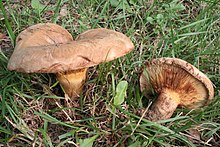
The gray alder forms root nodules in which the nitrogen in the air is bound and thus usable for the plant. This is done by one as Actinorhiza called symbiosis with the bacterium Frankia alni . This increases the nitrogen content of the leaves, and with their breakdown also the content of nitrogen compounds in the soil, which leads to a soil improvement. For a 30-year-old gray alder population, investigations showed an annually bound amount of nitrogen of 43 kg / ha, thickets of gray alder trees showed a value of 72 kg / ha, forest stands in the French Alps at 1,450 meters above sea level could produce 42.5 kg / ha ha tie.
The gray alder enters into a root symbiosis ( ectomycorrhiza ) with several types of soil fungi, including the alder brood ( Gyrodon lividus ) and the bald curl ( Paxillus involutus ) .
Gray alder and hazel grouse
In Scandinavia and the Romanian Eastern Carpathians, the male kittens and the buds of the gray alder are the main food of the hazel grouse ( Tetrastes bonasia ) in winter . A hazel grouse eats around 50 grams of kittens and buds per day.
pathology

Gray alder are particularly by appearing only at the end of the 20th century known as Phytophthora alni risk. By Eipilz Phytophthora alni is special about the black alder, but also on the gray alder, the green alder and Herzblättrigen alder a root - and stem rot caused. The stem rot can lead to the death of trees after several months, but it can also drag on for years. The disease was first described in the south of England in 1993. It has since spread to Germany (first observed in 1995), Austria, France, Belgium, Italy, Ireland, Hungary, the Netherlands and Sweden. Symptoms are poor foliage, dead branches and particularly small, light-colored leaves. Black-brown, mostly oozing spots that appear on the base of the trunk are typical. The wood lying under the attacked areas is discolored from dark brown to reddish brown and is clearly differentiated from the healthy light wood. The infection occurs through wounds on the base of the trunk, through the hair root system or through cork pores. Analyzes have shown that the Phytophthora alni pathogen has only recently developed through hybridization.
Furthermore, the influence of the hose fungus Taphrina epiphylla can cause witch brooms . The mycelium overwinters in the buds and attacks the young leaves, which become dry and fall off prematurely. Only when there is a strong infestation of up to 100 witch's brooms are the alders so weakened that branches or entire trees die. Another type of tubular mushroom, Taphrina alni , is the causative agent of the "kitten disease", in which the bracts of the female inflorescences are attacked, causing them to become lobed, enlarged and discolored to dark red and so-called " fool's pockets ". The Alder Schillerporling ( Inonotus radiatus ) from the family of Stielporlingsrelatives (Polyporaceae) causes a rapidly spreading white rot . It often attacks weakened alders in damp locations and penetrates the wood through injuries. Species of the genus Mycosphaerella from the order of the soot-dew fungus cause angular, sharply delimited spots on the undersides of the leaves. In Finland the alder is also attacked by the root sponge ( Heterobasidion annosum ).
Among the harmful insects, the alder weevil (also alder strangler, Cryptorrhynchus lapathi ) from the family of weevils (Curculionidae) is the most dangerous. The larvae overwinter in the bark and drill up to 10 centimeters long tunnels in the wood. The young beetles feed on the young shoots. Typical symptoms of the infestation are withered shoots, distended parts of the bark, entrance holes and wood chips. Several species of butterflies (Lepidoptera) overwinter in the catkins and other feed on fruits and buds, Gespinstmotte argyresthia goedartella and several Epinotia TYPES from the family of Winder (Tortricidae). The blue alder leaf beetle ( Agelastica alni ) can eat alder up to three times a year in some areas. Considerable damage by the beetle beetle ( Agrilus viridis ) was also observed after heavy snow pressure.
Systematics
The gray alder is a member of the genus of alder ( Alnus ) in the family of Birch Family (Betulaceae). It is assigned to the subgenus Alnus in the genus Alnus , which also includes the black alder. The green alder is placed in the subgenus Alnobetula . The number of chromosomes in gray alder is 2n = 28.
The wide distribution of alders and the small differences have led to disagreement in the internal system. Several forms are seen partly as subspecies of Alnus incana , partly as separate species or only as varieties . Four subspecies of Alnus incana are frequently recognized: the nominate form Alnus incana subsp. incana , the subspecies Alnus incana subsp. hirsuta in Asia and Alnus incana subsp. rugosa and Alnus incana subsp. tenuifolia in North America. The three subspecies are also often seen as separate species Alnus hirsuta , Alnus rugosa and Alnus tenuifolia . Another red-leaved form Alnus incana f. rubra differentiated. The gray alder with its subspecies can be seen as a vicarious Holarctic species complex. Chen et al. summarize the following species in the complex: Alnus hirsuta , Alnus incana , Alnus rugosa , Alnus rubra , Alnus inokumae , Alnus tenuifolia , Alnus sibirica and also the black alder ( Alnus glutinosa ), but Alnus hirsuta , Alnus rugosa and Alnus tenuifolia are not viewed as a subspecies of the gray alder, but as a separate species.
Subspecies
In addition to the nominate form native to Europe and West Asia, the following taxa are often viewed as subspecies of Alnus incana . The assignment is controversial, however, the subspecies are classified by some authors as separate species, sometimes as varieties .
Dyer's alder ( Alnus incana subsp. Hirsuta )
The dyer alder ( Alnus incana subsp. Hirsuta (Spach) Á.Löve & D.Löve or Alnus hirsuta (Spach) Turcz. , Synonym : Alnus tinctoria . Coffin ) is a 10 to 15, a maximum of up to 20 meters tall tree, with an initially broadly conical crown. The bark is black-brown, the shoots are initially covered with thick tufts of hair, later glabrous and gray with frost. The leaves are broadly ovate to ovate-elliptical, briefly pointed with a wedge-shaped base and 4 to 9 inches long and 2.5 to 9 inches wide. 9 to 12 pairs of nerves are formed. The leaf margin is slightly lobed and double serrated. The upper side of the leaf is dark green and slightly hairy, the underside is blue-green, and the nerves are hairy reddish brown. The leaf stalk becomes 2.5 to 4 inches long. The male kittens are 5 to 7 centimeters long and stand alone or in pairs. The cones are in groups of three or four, are about 2.5 inches long, short-stalked and sessile. The distribution area of the dye alder includes Japan, Korea, China, Sakhalin , Kamchatka and eastern Siberia . It grows at heights of 700 to 1500 meters.
Alnus incana subsp. kolaensis
The subspecies Alnus incana subsp. kolaensis (Orlova) Á.Löve & D.Löve occurs in Norway, Sweden and Finland.
Wrinkled alder ( Alnus incana subsp. Rugosa )
The wrinkled alder ( Alnus incana subsp. Rugosa (Du Roi) RT Clausen or Alnus rugosa (Du Roi) Spreng. ) Usually grows shrub-like, less often than a tree, and then becomes up to 9 meters high. The branches are hairless or rust-brown, the buds have stems 2 to 4 millimeters long. The leaf blades are elliptical to broadly ovate with a wedge-shaped or rounded base and a pointed or blunt apex. They become 4 to 11 centimeters long and 3 to 8 centimeters wide, form 10 to 15 pairs of nerves and have a double-serrated and slightly lobed leaf margin. The upper side of the leaf is bare, the underside is gray-green to blue-green and hairy brown on the nerves. The male inflorescences are in groups of two to four catkins and are 2 to 7 centimeters long, the female inflorescences form several groups of two to six catkins and are upright to flower. The cones are egg-shaped, 1 to 1.7 inches long and 0.8 to 1.2 inches wide and have 1 to 5 millimeters long stems.
The natural range extends over the east of Canada (provinces of Manitoba , New Brunswick , Newfoundland and Labrador , Nova Scotia , Ontario , Prince Edward Island , Québec and Saskatchewan ), the island group of Saint-Pierre and Miquelon and the northeast of the USA (from North Dakota and Maine to Iowa , Illinois , West Virginia and New Jersey ). The range overlaps in the west, in Saskatchewan and Manitoba, with the range of the subspecies tenuifolia and in the south with the hazel alder ( Alnus serrulata ). The subspecies grows at heights of 0 to 800 meters.
Alnus incana subsp. tenuifolia
The subspecies Alnus incana subsp. tenuifolia (Nutt.) Spreading is also known as a variety of the subspecies Alnus incana subsp. rugosa classified. Synonyms are Alnus incana subsp. rugosa var. occidentalis (Dippel) CLHitchc. or Alnus tenuifolia Nutt. . It differs from the subspecies rugosa by the thinner, paper-like leaf blade and the more rounded leaf edge. It grows tree-like more often than the subspecies rugosa , but can also be shrubby. Trees reach a height of 12 meters. The leaf blade is ovate to elliptical, thin, 4 to 10 inches long and 2.5 to 8 inches wide. The leaf base is broadly wedge-shaped to rounded, the leaf edge is double serrated to notched or lobed. The male inflorescences are groups of three to five catkins 4 to 10 centimeters long, the female inflorescences consist of groups of two to five catkins. The cones are egg-shaped, 1 to 2 inches long and 0.8 to 1.3 inches wide and have 1 to 5 millimeter long stems.
The distribution area extends from Alaska over the west of Canada (provinces Alberta , British Columbia , Northwest Territories , Saskatchewan and Yukon ) and over the west of the USA to California , Colorado and New Mexico . It thrives at altitudes of 100 to 3000 meters and can often be found on river banks in the Rocky Mountains and other mountainous landscapes in western North America.
Hybrids and Cultures
In the Baltic states, natural hybrids between gray alder and black alder ( Alnus incana × Alnus glutinosa ) that show luxuriant growth are common. The hybrids are on average 16% taller and have a 45% larger diameter at chest height than the gray alder and are 12% taller and 33% stronger than the black alder. One can distinguish the hybrids by the ratio of the length of the spade to the width of the width (black-alder 1.15, bastard 1.26, gray-alder 1.41) and the number of pairs of lateral nerves (black-alder 6 to 7, bastard 7 to 9, Gray alder 10 to 12).
A distinction is made between several forms of culture , including:
- 'Aurea': an up to 10 meters high, often multi-stemmed tree. The young shoots are constantly yellow and turn orange-yellow in winter. The young catkins are orange, the sprouting leaves are yellow-green and later turn light green.
- 'Laciniata': a 10 to 12 meter high tree with unevenly large, finely and deeply incised, light green leaves.
- 'Pendula': with drooping branches.
Common names
Further names for the gray alder, some of which are only used regionally, are or were: Auerle ( Austria ), Prussian alder , red alder (Austria) and white alder .
use
Wood
→ Main article: Alder wood
Both gray alder and black alder wood are used as alder wood. There are no significant physical or mechanical differences between the two types of wood. The wood of the gray alder is used less often, however, as it rarely reaches dimensions suitable for timber and the trunk shape is usually unfavorable. Only under optimal conditions, such as in the Baltic States and Finland, does it grow into straight, smooth-stemmed, larger-sized trees.
Alder wood is soft and has an even, fine structure. It has a gross density of 550 kg / m³ with a wood moisture content of 12 to 15% and thus belongs to the medium-heavy native wood species. The wood is not very strong and not very elastic and in these properties it is comparable to limewood . Exposed to the weather or in contact with the earth, it is not very durable, but when installed under water it shows a similarly high durability as oak wood . The wood is easy to work with and can be easily sawed, sliced and peeled, it is easy to mill , turn and carve . Screws hold well and can be glued well, but the wood is not very nail-proof and tends to splinter when nailing. Surface treatment such as polishing , pickling and painting is unproblematic. When it comes into contact with iron, gray discolouration occurs in the presence of moisture, and the iron itself corrodes. Alder wood is also highly reactive in contact with cement.
The wood is used as firewood and as pulpwood, for the production of chipboard, chipboard molded parts and fiberboard. It is a good starting material for paper production, but is also used for woodturning and for making toys and wooden shoes. The alder provides a high-quality blind wood for furniture and interior fittings, due to its good stainability, alder wood is also used to imitate precious woods. Special types of charcoal are made from alder wood, which are used as drawing charcoal, soldering charcoal and laboratory charcoal.
Other uses
The main use of the gray alder is the stabilization of slopes and embankments, torrent control and soil improvement in nutrient-poor wasteland. It is also used to reforest brown coal and spoil heaps. They are also used to protect species endangered by late frost among the gray alders.
proof
literature
- Peter Schütt, Horst Weisgerber, Hans J. Schuck, Ulla Lang, Bernd Stimm, Andreas Roloff: Encyclopedia of Deciduous Trees . Nikol, Hamburg 2006, ISBN 3-937872-39-6 , pp. 97-106 .
- Andreas Roloff, Andreas Bärtels: Flora of the woods. Purpose, properties and use . 3rd, corrected edition. Eugen Ulmer, Stuttgart (Hohenheim) 2008, ISBN 978-3-8001-5614-6 , pp. 99-101 .
- Peter Schütt , Hans Joachim Schuck, Bernd Stimm (eds.): Lexicon of tree and shrub species. The standard work of forest botany. Morphology, pathology, ecology and systematics of important tree and shrub species . Nikol, Hamburg 2002, ISBN 3-933203-53-8 , pp. 37 (reprinted 1992).
Individual evidence
- ↑ a b c d e f D. Grosser, W. Teetz: Erle . In: Local timber (loose-leaf collection) . No. 16 . Information service wood, wood sales fund - sales promotion fund of the German forest and wood industry, 1998, ISSN 0446-2114 .
- ↑ a b c d e f Schütt et al .: Lexicon of Tree and Shrub Species , p. 37
- ↑ a b c d Schütt et al .: Encyclopedia of Deciduous Trees , p. 99
- ↑ a b c d Schütt et al .: Encyclopedia of Deciduous Trees , p. 100
- ↑ a b Roloff et al .: Flora of the Woods , p. 100
- ↑ a b Erich Oberdorfer : Plant-sociological excursion flora for Germany and neighboring areas . 8th edition. Verlag Eugen Ulmer, Stuttgart 2001, ISBN 3-8001-3131-5 . Page 315.
- ↑ a b c Schütt et al .: Encyclopedia of Deciduous Trees , p. 98
- ↑ a b c Schütt et al .: Encyclopedia of Deciduous Trees , p. 103
- ↑ After A. Schwabe: Monograph Alnus incana-rich forest communities in Europe. Variability and similarities of an azonally widespread social group . In: Phytocoenologia. Volume 13, 1985 pp. 197-302, modified from Schütt, Weisgerber, Schuck, Lang, Stimm, Roloff: Encyclopedia of the deciduous trees. Nikol, Hamburg 2006, ISBN 3-937872-39-6 , p. 98. Supplemented by data from Eric Hultén: Alnus incana. In: The Linnaeus Server. Swedish Museum of Natural History, March 14, 2004, accessed February 14, 2010 (Swedish).
- ↑ a b Schütt et al .: Encyclopedia of Deciduous Trees , p. 105
- ^ Federal Institute for Food and Agriculture (BLE) . Retrieved April 23, 2015.
- ↑ Erhard Dörr, Wolfgang Lippert : Flora of the Allgäu and its surroundings. Volume 1, IHW, Eching 2001, ISBN 3-930167-50-6 , p. 424.
- ↑ a b c Schütt et al .: Encyclopedia of Deciduous Trees , p. 102
- ↑ a b Thoma Paulus, Sabine Werres: Erlensterben by Phytophthora on flowing waters. University of Duisburg Essen, March 14, 2005, accessed on September 3, 2014 .
- ^ A b Paul Heydeck: Current focuses of the occurrence of fungal pathogens in the forests of Brandenburg. (pdf) (No longer available online.) In: Eberswalder Forstliche Schriftenreihe, Volume XXXV. Landesforstanstalt Eberswalde, 2008, pp. 41–42 , archived from the original on September 2, 2014 ; Retrieved December 30, 2009 . Info: The archive link was inserted automatically and has not yet been checked. Please check the original and archive link according to the instructions and then remove this notice.
- ↑ a b c Schütt et al .: Encyclopedia of Deciduous Trees , p. 104
- ↑ a b c Zhiduan Chen, Jianhua Li: Phylogenetics and Biogeography of Alnus (Betulaceae) Inferred from Sequences of Nuclear Ribosomal DNA ITS Region . In: International Journal of Plant Sciences . tape 165 , no. 2 . University of Chicago Press, Chicago 2004, pp. 325-335 .
- ↑ a b Ronald J. Uchytal: Alnus incana subsp. tenuifolia. US Department of Agriculture, Forest Service, 1989, archived from the original on October 22, 2008 ; accessed on December 29, 2009 .
- ^ A b John J. Furlow: Betulaceae. In: Flora of North America Editorial Committee (Ed.): Flora of North America North of Mexico . Volume 3: Magnoliophyta: Magnoliidae and Hamamelidae . Oxford University Press, New York / Oxford a. a. 1997, ISBN 0-19-511246-6 , Alnus incana , p. 513 (English, online ).
- ↑ Peter A. Schmidt: On the systematics and variability of the Central European alders (genus Alnus Mill.) . In: Communications of the German Dendrological Society . tape 82 , 1996, ISBN 3-8001-8315-3 , pp. 15-42 . quoted from Schütt et al .: Encyclopedia of Deciduous Trees , pp. 101-102
- ↑ a b Roloff et al .: Flora of the Woods , p. 99
- ↑ a b Pei-chun Li, Alexei K. Skvortsov: Betulaceae. In: Wu Zheng-yi, Peter H. Raven (Ed.): Flora of China . Volume 4: Cycadaceae through Fagaceae . Science Press / Missouri Botanical Garden Press, Beijing / St. Louis 1999, ISBN 0-915279-70-3 , Alnus hirsuta , p. 286 (English, online ).
- ↑ Rafaël Govaerts (Ed.): Alnus - World Checklist of Selected Plant Families of the Royal Botanic Gardens, Kew. Last accessed on January 10, 2017.
- ↑ Roloff et al .: Flora of the Woods , p. 101
- ^ A b John J. Furlow: Betulaceae. In: Flora of North America Editorial Committee (Ed.): Flora of North America North of Mexico . Volume 3: Magnoliophyta: Magnoliidae and Hamamelidae . Oxford University Press, New York / Oxford a. a. 1997, ISBN 0-19-511246-6 , Alnus incana subsp. rugosa , S. 513 (English, online ).
- ^ A b John J. Furlow: Betulaceae. In: Flora of North America Editorial Committee (Ed.): Flora of North America North of Mexico . Volume 3: Magnoliophyta: Magnoliidae and Hamamelidae . Oxford University Press, New York / Oxford a. a. 1997, ISBN 0-19-511246-6 , Alnus incana subsp. tenuifolia , S. 513-514 (English, online ).
- ^ Jost Fitschen: Woody flora . 12th, revised and expanded edition. Quelle & Meyer, Wiebelsheim 2007, ISBN 3-494-01422-1 , p. 941 .
- ^ Georg August Pritzel , Carl Jessen : The German folk names of plants. New contribution to the German linguistic treasure. Philipp Cohen, Hannover 1882, p. 21, online.
Web links
- Alnus incana in the Germplasm Resources Information Network (GRIN), USDA , ARS , National Genetic Resources Program. National Germplasm Resources Laboratory, Beltsville, Maryland. Retrieved December 31, 2009.
- Gray alder. In: FloraWeb.de.
- Gray alder . In: BiolFlor, the database of biological-ecological characteristics of the flora of Germany.
- Profile and distribution map for Bavaria . In: Botanical Information Hub of Bavaria .
- Alnus incana (L.) Moench In: Info Flora , the national data and information center for Swiss flora .
- Distribution in the northern hemisphere from: Eric Hultén, Magnus Fries: Atlas of North European vascular plants. 1986, ISBN 3-87429-263-0 at Den virtuella floran. (swed.)
- Thomas Meyer: Data sheet with identification key and photos at Flora-de: Flora von Deutschland (old name of the website: Flowers in Swabia )
